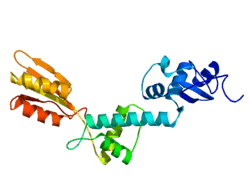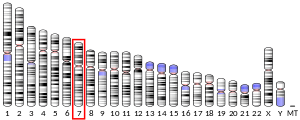SBDS
Ribosome maturation protein SBDS is a protein that in humans is encoded by the SBDS gene.[5] An alternative transcript has been described, but its biological nature has not been determined. This gene has a closely linked pseudogene that is distally located.[6] This gene encodes a member of a highly conserved protein family that exists from archaea to vertebrates and plants.
Function
The encoded protein plays an essential role in ribosome biogenesis. SBDS interacts with elongation factor-like GTPase 1 (Efl1) to disassociate eukaryotic initiation factor 6 (eIF6) from the late cytoplasmic pre-60S ribosomal subunit allowing assembly of the 80S[6]. Dynamic rotation of the SBDS protein in the ribosomal P site is coupled to a conformational switch in EFL1 that promotes eIF6 displacement through competition for an overlapping binding site on the 60S ribosomal subunit[7]. Yeast SBDS ortholog, Sdo1, functions within a pathway containing Efl1 to facilitate the release and recycling of the nucleolar shuttling factor Tif6 (yeast eIF6 ortholog) from late cytoplasmic pre-60S ribosomal subunit[8]. Knockdown of SBDS expression results in increased apoptosis in erythroid cells undergoing differentiation due to elevated ROS levels[9]. Hence SBDS is critical for normal erythropoiesis[10].
This family is highly conserved in species ranging from archaea to vertebrates and plants. The family contains several Shwachman-Bodian-Diamond syndrome (SBDS) proteins from both mouse and humans. Shwachman-Diamond syndrome is an autosomal recessive disorder with clinical features that include pancreatic exocrine insufficiency, haematological dysfunction and skeletal abnormalities. Members of this family play a role in RNA metabolism[5][11].
A number of uncharacterised hydrophilic proteins of about 30 kDa share regions of similarity. These include,
- Mouse protein 22A3.
- Saccharomyces cerevisiae chromosome XII hypothetical protein YLR022c.
- Caenorhabditis elegans hypothetical protein W06E11.4.
- Methanococcus jannaschii hypothetical protein MJ0592.
This particular protein sequence is highly conserved in species ranging from archaea to vertebrates and plants.[5]
Structure
The SBDS protein contains three domains, an N-terminal conserved FYSH domain, central helical domain and C-terminal domain containing an RNA-binding motif.[9]
N-terminal domain
| SBDS protein N-terminal domain | |||||||||
|---|---|---|---|---|---|---|---|---|---|
| Identifiers | |||||||||
| Symbol | SBDS | ||||||||
| Pfam | PF01172 | ||||||||
| InterPro | IPR019783 | ||||||||
| PROSITE | PDOC00974 | ||||||||
| SCOPe | 1nyn / SUPFAM | ||||||||
| |||||||||
This protein domain appears to be very important, since mutations in this domain are usually the cause of Shwachman-Bodian-Diamond syndrome. It shares distant structural and sequence homology to a protein named YHR087W found in the yeast Saccharomyces cerevisiae. The protein YHR087W is involved in RNA metabolism, so it is probable that the SBDS N-terminal domain has the same function.[11]
The N-terminal domains contains a novel mixed alphabeta fold, four beta-strands, and four alpha-helices arranged as a three beta stranded anti-parallel-sheet.[11]
Central domain
The function of this protein domain has been difficult to elucidate. It is possible that it has a role in binding to DNA or RNA. Protein binding to form a protein complex is also another possibility. It has been difficult to infer the function from the structure since this particular domain structure is found in archea.[11]
This domain contains a very common structure, the winged helix-turn-helix.[11]
C-terminal domain
| SBDS protein C-terminal domain | |||||||||
|---|---|---|---|---|---|---|---|---|---|
| Identifiers | |||||||||
| Symbol | SBDS_C | ||||||||
| Pfam | PF09377 | ||||||||
| InterPro | IPR018978 | ||||||||
| SCOPe | 1nyn / SUPFAM | ||||||||
| |||||||||
In molecular biology, the SBDS C-terminal protein domain is highly conserved in species ranging from archaea to vertebrates and plants.[12]
Members of this family are thought to play a role in RNA metabolism.[11] However, its precise function remains to be elucidated. Furthermore, its structure makes it very difficult to predict the protein domain's function.[11]
The structure of the C-terminal domain contains a ferredoxin-like fold[13] This structure has a four-stranded beta-sheet with two helices on one side.[11]
Clinical significance
Mutations within this gene are associated with Shwachman-Bodian-Diamond syndrome.[6] The two most common mutations associated with this syndrome are at positions 183–184 (TA→CT) resulting in a premature stop-codon (K62X) and a frameshift mutation at position 258 (2T→C) resulting in a stopcodon (C84fsX3).[9]
References
- GRCh38: Ensembl release 89: ENSG00000126524 - Ensembl, May 2017
- GRCm38: Ensembl release 89: ENSMUSG00000025337 - Ensembl, May 2017
- "Human PubMed Reference:". National Center for Biotechnology Information, U.S. National Library of Medicine.
- "Mouse PubMed Reference:". National Center for Biotechnology Information, U.S. National Library of Medicine.
- Boocock GR, Morrison JA, Popovic M, Richards N, Ellis L, Durie PR, Rommens JM (January 2003). "Mutations in SBDS are associated with Shwachman-Diamond syndrome". Nature Genetics. 33 (1): 97–101. doi:10.1038/ng1062. PMID 12496757.
- "Entrez Gene: SBDS Shwachman-Bodian-Diamond syndrome".
- Weis F, Giudice E, Churcher M, Jin L, Hilcenko C, Wong CC, et al. (November 2015). "Mechanism of eIF6 release from the nascent 60S ribosomal subunit". Nature Structural & Molecular Biology. 22 (11): 914–9. doi:10.1038/nsmb.3112. PMC 4871238. PMID 26479198.
- Menne TF, Goyenechea B, Sánchez-Puig N, Wong CC, Tonkin LM, Ancliff PJ, et al. (April 2007). "The Shwachman-Bodian-Diamond syndrome protein mediates translational activation of ribosomes in yeast". Nature Genetics. 39 (4): 486–95. doi:10.1038/ng1994. PMID 17353896.
- Orelio C, van der Sluis RM, Verkuijlen P, Nethe M, Hordijk PL, van den Berg TK, Kuijpers TW (2011). "Altered intracellular localization and mobility of SBDS protein upon mutation in Shwachman-Diamond syndrome". PLOS ONE. 6 (6): e20727. Bibcode:2011PLoSO...620727O. doi:10.1371/journal.pone.0020727. PMC 3113850. PMID 21695142.
- Sen S, Wang H, Nghiem CL, Zhou K, Yau J, Tailor CS, et al. (December 2011). "The ribosome-related protein, SBDS, is critical for normal erythropoiesis". Blood. 118 (24): 6407–17. doi:10.1182/blood-2011-02-335190. PMID 21963601.
- Savchenko A, Krogan N, Cort JR, Evdokimova E, Lew JM, Yee AA, et al. (May 2005). "The Shwachman-Bodian-Diamond syndrome protein family is involved in RNA metabolism". The Journal of Biological Chemistry. 280 (19): 19213–20. doi:10.1074/jbc.M414421200. PMID 15701634.
- Boocock GR, Morrison JA, Popovic M, Richards N, Ellis L, Durie PR, Rommens JM (January 2003). "Mutations in SBDS are associated with Shwachman-Diamond syndrome". Nature Genetics. 33 (1): 97–101. doi:10.1038/ng1062. PMID 12496757.
- Shammas C, Menne TF, Hilcenko C, Michell SR, Goyenechea B, Boocock GR, et al. (May 2005). "Structural and mutational analysis of the SBDS protein family. Insight into the leukemia-associated Shwachman-Diamond Syndrome". The Journal of Biological Chemistry. 280 (19): 19221–9. doi:10.1074/jbc.M414656200. PMID 15701631.
Further reading
- Lai CH, Chou CY, Ch'ang LY, Liu CS, Lin W (May 2000). "Identification of novel human genes evolutionarily conserved in Caenorhabditis elegans by comparative proteomics". Genome Research. 10 (5): 703–13. doi:10.1101/gr.10.5.703. PMC 310876. PMID 10810093.
- Popovic M, Goobie S, Morrison J, Ellis L, Ehtesham N, Richards N, et al. (April 2002). "Fine mapping of the locus for Shwachman-Diamond syndrome at 7q11, identification of shared disease haplotypes, and exclusion of TPST1 as a candidate gene". European Journal of Human Genetics. 10 (4): 250–8. doi:10.1038/sj.ejhg.5200798. PMID 12032733.
- Nakashima E, Mabuchi A, Makita Y, Masuno M, Ohashi H, Nishimura G, Ikegawa S (March 2004). "Novel SBDS mutations caused by gene conversion in Japanese patients with Shwachman-Diamond syndrome". Human Genetics. 114 (4): 345–8. doi:10.1007/s00439-004-1081-2. PMID 14749921.
- Woloszynek JR, Rothbaum RJ, Rawls AS, Minx PJ, Wilson RK, Mason PJ, et al. (December 2004). "Mutations of the SBDS gene are present in most patients with Shwachman-Diamond syndrome". Blood. 104 (12): 3588–90. doi:10.1182/blood-2004-04-1516. PMID 15284109.
- Andersen JS, Lam YW, Leung AK, Ong SE, Lyon CE, Lamond AI, Mann M (January 2005). "Nucleolar proteome dynamics". Nature. 433 (7021): 77–83. Bibcode:2005Natur.433...77A. doi:10.1038/nature03207. PMID 15635413.
- Kuijpers TW, Alders M, Tool AT, Mellink C, Roos D, Hennekam RC (July 2005). "Hematologic abnormalities in Shwachman Diamond syndrome: lack of genotype-phenotype relationship". Blood. 106 (1): 356–61. doi:10.1182/blood-2004-11-4371. PMID 15769891.
- Austin KM, Leary RJ, Shimamura A (August 2005). "The Shwachman-Diamond SBDS protein localizes to the nucleolus". Blood. 106 (4): 1253–8. doi:10.1182/blood-2005-02-0807. PMC 1895203. PMID 15860664.
- Kawakami T, Mitsui T, Kanai M, Shirahata E, Sendo D, Kanno M, et al. (July 2005). "Genetic analysis of Shwachman-Diamond syndrome: phenotypic heterogeneity in patients carrying identical SBDS mutations". The Tohoku Journal of Experimental Medicine. 206 (3): 253–9. doi:10.1620/tjem.206.253. PMID 15942154.
- Boocock GR, Marit MR, Rommens JM (June 2006). "Phylogeny, sequence conservation, and functional complementation of the SBDS protein family". Genomics. 87 (6): 758–71. doi:10.1016/j.ygeno.2006.01.010. PMID 16529906.
- Erdos M, Alapi K, Balogh I, Oroszlán G, Rákóczi E, Sümegi J, Maródi L (November 2006). "Severe Shwachman-Diamond syndrome phenotype caused by compound heterozygous missense mutations in the SBDS gene". Experimental Hematology. 34 (11): 1517–21. doi:10.1016/j.exphem.2006.06.009. PMID 17046571.
- Nishimura G, Nakashima E, Hirose Y, Cole T, Cox P, Cohn DH, et al. (April 2007). "The Shwachman-Bodian-Diamond syndrome gene mutations cause a neonatal form of spondylometaphysial dysplasia (SMD) resembling SMD Sedaghatian type". Journal of Medical Genetics. 44 (4): e73. doi:10.1136/jmg.2006.043869. PMC 2598034. PMID 17400792.
- Calado RT, Graf SA, Wilkerson KL, Kajigaya S, Ancliff PJ, Dror Y, et al. (August 2007). "Mutations in the SBDS gene in acquired aplastic anemia". Blood. 110 (4): 1141–6. doi:10.1182/blood-2007-03-080044. PMC 1939897. PMID 17478638.
- Wang Y, Yagasaki H, Hama A, Nishio N, Takahashi Y, Kojima S (November 2007). "Mutation of SBDS and SH2D1A is not associated with aplastic anemia in Japanese children". Haematologica. 92 (11): 1573. doi:10.3324/haematol.11568. PMID 18024409.
External links
- GeneReviews/NIH/NCBI/UW entry on Shwachman-Diamond Syndrome
- Overview of all the structural information available in the PDB for UniProt: Q9Y3A5 (Ribosome maturation protein SBDS) at the PDBe-KB.




